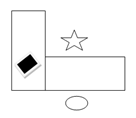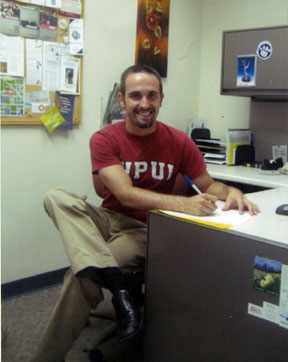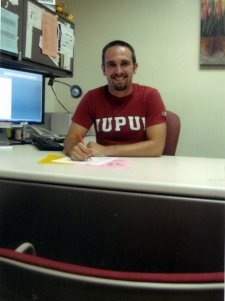Approachable” “Intimidating” “Unprofessional” “ Credible'
What do our offices say about us?
Authored by: James Eckerty
2011
As academic advisors, we search for new tools to create collaborative academic experiences with our students whether in our office, in the classroom, or on the internet. In our offices we display photos from home, have a plant or two, play music softly, or even rearrance our office furniture, all in hopes of creating a more engaging environment. This article and accompanying appendices:
- examines the importance of using physical environment as an advising tool;
- provides rich quantitative and qualitative data from a study focused on student experiences before, during, and after an advising session;
- explains three things every advisor can immediately do to provide a more welcoming environment for their students.
Oblinger (2006) noted that space can have an impact on learning. Positive spaces bring people together as they encourage exploration, collaboration, and discussion; negative spaces can carry an unspoken message of silence and disconnectedness, sometimes stronger than verbalization (p. 1). Academic advisors have important conversations with students regarding their current and future experiences in college; our offices should reflect this by providing a relaxed and collaborative environment needed for these conversations to occure. Brown and Long (2006) agree with this belief noting that learning occurs everywhere, whether we arrange spaces or not, but deeper and richer learning occurs when the design encourages interactively (p. 6). An example that illustrates this principle is an IUPUI project that designed new informal learning spaces in what has been a long corridor that had no purpose (Chism, 2006b). Chism (2006b), stated that new learning environments demonstrate that not all learning takes place in classrooms, and that the establishment of places for collaboration, project work, or socialization can directly influence student success and persistence (p. 18). Vaughn (1991), affirmed this saying, "Good rooms enable good teaching" (p.12).
Initial survey of academic advisors
A literature search for physical environments that impact student learning uncovered articles on classroom and building spaces but none of the information needed to help academic advisors better structure their office spaces. So, I designed a short survey for fellow advisors within the Office of Academic and Career Development (ACD) at IUPUI to gather advisor perceptions of their advising spaces. The survey queried advisors who used one of two different office layouts. Results found that advisors with office layout A (see Appendix A ) found it easier to work with students, thought they collaborated better with students, and were more aware of students’ body language. Advisors with office layout B (see Appendix A ) thought that the desk between them and the student provided more work space to help students. (Note: not all advisors could choose their preferred office arrangement; some advisors were unable to move their furniture due room design.) Two advisors switched from layout B to A; they remarked upon differences noted in student comfort level. These advisors thought that layout A allowed for more relaxed conversations. Likewise these two advisors felt that office layout B put them in a more authoritative position and sometimes intimidated students.
Further Study
Within a year of receiving results of the advisor survey I developed an IRB approved, pre- and post-advising survey for students to study students’ preferred office design. This environmental study observed two common desk layouts within universities nationwide, their impact on students’ first impression of the advisor, and the impact of the office layout on collaboration between students and their advisor (See Appendix A for layouts of office A and B).
Pre-advising session Survey protocol
The pre-advising survey focused on demographic information with a question asking participants to examine two photos and select the more approachable advisor. The same advisor was used in each picture, the advisor wore the same clothing and had the same position in regard to the camera; the desk layout was the only thing different. At the end of the survey students were made aware of a follow-up survey they would complete after their advising session; this survey would focus on the office environment not on the advisor or the content of the advising session. Students were told to be aware of their first impression of the office and to make a conscious note of the placement of their chair relative to the advisor.
Post-advising session survey protocol
The post-advising survey was conducted immediately following the completion of the advising session; students placed completed surveys in an envelope labeled “Survey 2” before they left the advisor’s office. In an attempt to screen out as many external variables as possible, six female advisors were carefully selected for this study based upon their current office layouts and advising experience. This survey quantitatively and qualitatively measured participants’ opinions on the office layout, their seat placement relative to the advisor, and their perceived level of collaboration with the advisor during the advising session.
Results
The study took place over 20 days and included results from 125 participants who completed both the pre- and post-advising surveys. Matching pre-and-post results, allowed me to investigate if office layout had an impact on students’ first impression of the advisor, as well as each student’s perceived level of collaboration with the advisor during the session (See Appendix B and Appendix C for the pre- and post-advising surveys)
Pre-advising session survey results
Demographic information from the participants can be seen in Appendix D. Based on the photogenic study, 49.6% of students said that office A had the more approachable advisor; 50.4% chose office B as having the more approachable advisor. The following chart shows the top four qualitative responses from students asked why one advisor appeared more approachable. (Keep in mind, the same advisor was used for both pictures, see Appendix Bfor the actual survey):
|
Office
|
Office B
|
|
Environment appears relaxing = 47%
|
Advisor appears more professional = 41%
|
|
Advisor appears easier to talk to = 13%
|
Familiar environment(past experiences) = 20%
|
|
Enjoy not having a barrier (desk) = 13%
|
Advisor appears ready/eager to help = 17%
|
|
Advisor appears more friendly = 11%
|
Desk has more space to work with = 14%
|
Not only do the qualitative responses noted above support the results of the initial advising survey, but they show that with just a switch of the desk, advisors can create a different experience for students.
Post-advising session survey
Although the questions asked on the post-advising survey showed that students found both office layouts welcoming. However the student comments should serve as a wake-up call for advisors: our physical environments can be a powerful tool for creating welcoming and collaborative environments. Results from the qualitative responses to the post-survey confirm that the layout of Office A created an environment that “allows for better and easier communication” and participants repeatedly referred to the discussion with the advisor as being “more like talking with a friend.” One participant shared that “the seat placement is placed in the way that there is no superior-subordinate feeling.”
Participants were asked how their seat placement impacted their expectations of the advising session. Responses to this question provided the most variation between the two layouts. Almost half of the “Office A” students noted that the seat placement set the mood for the advising session while only a quarter indicated that the seat placement in “Office B” changed their reaction for the better.
The variations between the two layouts appeared to make little difference once the students moved beyond the initial impressions into the advising session. At least eighty percent of the students in both office layout groups noted that they frequently asked questions and collaborated with their advisors during their advising session. A few participants who met with an advisor in “Office A” would have preferred a desk between the advisor and themselves. Some Office B participants said it was “very spacious and neatly arranged;” they felt it was a normal professional layout, and the advisor “was approachable and comfortable.” Both office layouts received positive remarks for good eye contact with advisor and being able to see the computer.
Students noted in their comments that variables besides desk layout have a greater impact on collaboration and impression of the advisor. These variables include, but are not limited to, advisors greeting students in the lobby and walking them to their office, advisor expertise in advising techniques, advisor knowledge of campus information, and advisor ability to answer the questions brought by student.
Discussion
Results of this study were used to examine if office environments impact collaboration between advisors and their students. While there are many things in our offices that could have an impact on collaboration, desk layout was examined using two desk layouts within the IUPUI Office for Academic and Career Development (ACD). Results of the pre-advising survey show that students’ first impressions of their advisors are greatly impacted by desk placement. However, after examining post-advising survey results, it appears that only the chair placement in the “Office A” layout set the mood of the advising session and that other variables besides desk layout may have a greater impact on initial impression and collaboration with the advisor.
Though one physical environment did not significantly create a more collaborative experience, results showed that each physical environment created a different initial impression of the advisor. “Office A” created a more relaxing environment and allowed for easier conversation with their advisor. Students found that the “Office B” layout “project[ed] an in control feeling” that put the advisor in a more authoritative role. Student comments illustrated that in both office layouts students found positive benefits regarding their seat placement in relation to their advisor; they appreciated being able to sit face-to-face to make eye contact and being able to see the computer screen and what the advisor was typing.
Three themes emerged from the qualitative or “write in” responses provided by participants in the pre- and post- surveys. Advisors can use these results to create a more comfortable environment for collaboration.
- Students want to see documents, whether on the computer screen or on paper; they want to know the content of documents so they can be more involved in discussions.
- Students find that clutter is a distraction to what they are trying to accomplish. The more clutter, the less time they feel the advisor has for them.
- Students appreciate a clear walkway to their chair when entering and exiting the office (students want to immediately know where they should sit when entering room).
Based upon student comments I recommend, if possible, that advisors greet students in a Center’s lobby and walk them to the advisor’s office. In thinking about the physical environment advisors should consider how they interact with students; do we want to project that advising is collaborative and that advisors support students? Or do we want to convey that advising is more authoritative? Findings show participants who met their advisor in “Office A” thought the environment was relaxing and that talking with the advisor was more like talking with a friend. Participants who met an advisor in “Office B” said the environment was more familiar and professional, but some said that it felt “more like an interview” or was intimidating. I should be noted that no matter which office layout is used, it is up to the advisor to create a collaborative environment for their everyday conversations with students.
Conclusion
This study was grew from an observation that roughly half of the advisors in Academic and Career Development (ACD) had one office layout while the other half had another. ACD advisors are trained on the same policies, advising strategies, and data programs to create the best experience with students. I wanted to examine if the two different office layouts impacted collaboration with our students. While one layout was slightly better for initial impression, both layouts appeared to contribute to positive collaborations between advisor and advisee. However student qualitative (write-in) responses showed the office layout as a variable in creating the mood for the advising session and in students’ first impression of the advisor (whether more relaxing and friendly or more formal and professional).
Academic advisors should be aware of their office environment and use it to help create more rich and lasting conversations with students.. As Oblinger (2006) stated, our offices can carry unspoken messages of silence and disconnectedness for our students or positively encourage exploration, collaboration, and discussion (¶ 1). There are many variables besides desk placement that could be studied within an office. I challenge advisors to use the results of this research as a springboard to further study of the variables within our offices that can enhance student collaboration. My hope is that readers will use this research to create environments that fit their advising role while enhancing collaboration, exploration, and discussion with students.
Authored by:
James Eckerty
Indiana University Purdue University Indianapolis (IUPUI)
Author's note: This article is based upon the results of a research study presented at the Region V NACADA Conference in April 2010. The study was designed and implemented by James Eckerty with the help of his assessment mentor, Rob Aaron, and six colleagues who participated in the study. The author expresses a sincerer thank you to Dr. Aaron for everything!
References
Brown, M. & Long, P. D. (2006). Trends in learning space design. In D. G. Oblinger (Ed.) Learning spaces Retrieved from http://www.educause.edu/learningspacesch9
Chism, N. V. & Bickford, D. J. (2002). Improving the environment for learning: An expanded agenda. In the importance of physical space in creating supportive learning environments. InChism, N.V.N. & Bickford, D.J. (Eds.) The Importance of Physical Space in Creating Supportive Learning Environments: New Directions for Teaching and Learning, No. 92. pp. 91-97. San Francisco: Jossey-Bass.
Chism, N. V. (2006a). Challenging traditional assumptions and rethinking learning spaces. In Oblinger, D. G. (Ed.). Learning spaces. Retrieved from http://www.educause.edu/learningspacesch2
Chism, N. V. (2006b). Indiana University-Purdue University Indianapolis: The es corridor project. In Oblinger, D.G. (Ed). Learning spaces ). Retrieved from http://www.educause.edu/learningspacesch21
Council for the Advancement of Standards in Higher Education (2005). Academic advising programs: CAS standards and guidelines . Retrieved from http://www.cas.edu/getpdf.cfm?PDF=E864D2C4-D655-8F74-2E647CDECD29B7D0
Graetz, K. A. (2006). The psychology of learning environments. In Oblinger, D.G. (Ed.) Learning spaces. Retrieved from http://www.educause.edu/learningspacesch6
Hunley, S. & Schaller, M. (2006). Assessing learning spaces. In Oblinger, D.G. (Ed.) Learning spaces Retrieved from http://www.educause.edu/learningspacesch13
Oblinger, D. G. (2006). Spaces as a change agent. In Oblinger, D.G. (Ed.) Learning spaces Retrieved from http://www.educause.edu/learningspacesch1
Vaughan, T. (July-August 1991) Good Teaching Rooms: A Campus Resource. Academe, 77 (4), 11–15. Philadelphia: University of Pennsylvania
Appendix A
Description:

Office A

Office B
- A– Only a corner of the desk between the student and advisor; when turned, student can see screen of computer monitor that sits on the corner of the desk.
- B- Desk in between advisor and students; this is the more traditional layout we see in an academic setting.
Appendix B
(Pre-Survey: Was online but due to time, became a paper survey)
Welcome! Thank you for your participation in this exciting study! You are about to complete the first survey. You must complete all of the questions on the page in order to move on the next. Once complete, the last screen will contain short instructions on what to do next.
Please write your answers in the appropriate spaces provided.
1) Enter your Identification code for this study:
NOT IUPUI STUDENT ID #
2) Age
3) Ethnicity
Select one from drop down bar)
4 )Gender
M = male; F = female; T = transgender; O = other
5) What is the purpose of this advising session: (Click as many that apply to your visit)
(drop down list)
- Scheduling next semester (Not in Learning Community)
- Switching major
- Dropping/adding a class
- Learning Community appointment with advisor
- Probation/reinstatement session
- STAR session
- Removing a hold on my record
- Other: _____________________________
6) In which picture does the advisor appear more approachable based on the office layout?
Office A (49.6%)
Office B (50.4%)


6a) Briefly explain why you thought that picture made the advisor appear more approachable:
Appendix C
(Post Survey was paper and provided by advisor after advising session)
Read each question carefully and select the answer that best fits your experience.
1) What was your first reaction to the advisor's office as you walked in?
| Layout A |
Layout B |
(participants could select from the following responses) |
| 63% |
59% |
Very welcoming Office layout surpassed my expectations. |
| 37% |
41% |
Welcoming Office layout was welcoming. |
| 0% |
0% |
Unwelcoming – Office layout could have been a little more welcoming. |
| 0% |
0% |
Very unwelcoming – Office layout was very uninviting. |
2) What was your first reaction to the seat placement in relation to the advisor?
| Layout A |
Layout B |
|
| 74% |
71% |
Excellent – Placement made the advisor seem very approachable. |
| 26% |
26% |
Good placement made the advisor seem approachable. |
| 0% |
3% |
Poor placement made the advisor appear not as approachable. |
| 0% |
0% |
Unacceptable –Placement made the advisor appear very approachable. |
>Please explain ________________________________________________
3) (Based on your previous answer) Did your first impressions of the layout and chair placement change by the end of the session? (if yes, select Better or Worse)
| Layout A |
Layout B |
|
| 39% |
24% |
Yes; My reaction changed for the better. |
| 61% |
76% |
No; my reaction stayed the same throughout the session. |
4) My collaboration with the advisor during the session was:
| Layout A |
Layout B |
|
| 80% |
85% |
Frequent: I asked many questions; collaborated and worked together |
| 19% |
15% |
Fair: I asked a few questions; some collaboration |
| 1% |
0% |
Minimal: I only answered the questions the advisor asked me |
5) The placement of the chair impacted our collaboration and my expectations of the session:
| Layout A |
Layout B |
|
| 46% |
27% |
A lot: Felt it set the mood of the advising session. |
| 34% |
29% |
Some: Felt it had an influence on the session. |
| 9% |
12% |
Very little: Felt it would have been the same regardless of seat placement. |
6) Did you like the layout of the office?
| Layout A |
Layout B |
|
| 91% |
88% |
Yes |
| 0% |
0% |
No |
| 9% |
12% |
Did not make a difference |
YOU ARE DONE! Thank you for completing the second survey. Please give your instruction sheet to the advisor, and place your survey in the appropriate box near the exit.
Appendix D
Demographics of participants (Out of 125)
|
Age
|
Amount
|
|
|
18-19
|
92
|
74%
|
|
20-21
|
16
|
13%
|
|
22-24
|
8
|
6%
|
|
25+
|
9
|
7%
|
|
|
125
|
100%
|
|
Gender
|
|
|
|
Male
|
43
|
34.40%
|
|
Female
|
82
|
65.60%
|
|
|
125
|
100%
|
|
Ethnicity
|
|
|
| |
7
|
|
|
AfricanAmer
|
12
|
9.60%
|
|
Arabic
|
3
|
2.40%
|
|
Caucasian
|
91
|
72.80%
|
|
Int'l
|
8
|
6.40%
|
|
Indian
|
1
|
0.80%
|
|
Latino
|
2
|
1.60%
|
|
Mix
|
1
|
0.80%
|
|
|
125
|
100%
|
Cite this using APA style as:
Eckerty, J. (2011). 'Approachable” “Intimidating” “Unprofessional” “Credible':What do our offices say about us? Retrieved from the NACADA Clearinghouse of Academic Advising Resources website: http://www.nacada.ksu.edu/Resources/Clearinghouse/View-Articles/Office-Design-Research-Study.aspx